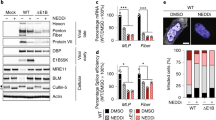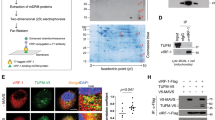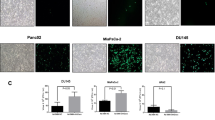Abstract
The adenovirus E4orf4 protein induces p53-independent death of human cancer cells by a mechanism requiring interactions with the Bα subunit of protein phosphatase 2A. When expressed alone E4orf4 localizes predominantly in the nucleus, although significant levels are also present in the cytoplasm. While tyrosine phosphorylation of E4orf4 and recruitment of Src have been linked with E4orf4 cytoplasmic cell death functions, little is known about the functions of E4orf4 in the nucleus. In this study, we identified an arginine-rich motif (E4ARM; residues 66–75) that is necessary and sufficient for nuclear and nucleolar localization. This motif, which is highly homologous to the arginine-rich nuclear and nucleolar localization motif of some lentiviral proteins, was shown to target heterologous proteins to the nucleus and to nucleoli, functions found to be dependent on the overall charge of the motif rather than on specific residues. Furthermore, mutation of arginine residues to alanines but not to lysines in E4ARM was shown to block such targeting activity and, when introduced into full-length E4orf4, to decrease induction of cell death. Finally, coexpression of the ARM motifs of E4orf4, HIV-1 Tat or Rev along with full-length E4orf4 was seen to decrease E4orf4-dependent cell killing. Thus it appears that targeting of E4orf4 to the nucleus and cell nucleoli by E4ARM is an important component of E4orf4-induced cell death.
This is a preview of subscription content, access via your institution
Access options
Subscribe to this journal
Receive 50 print issues and online access
$259.00 per year
only $5.18 per issue
Buy this article
- Purchase on Springer Link
- Instant access to full article PDF
Prices may be subject to local taxes which are calculated during checkout








Similar content being viewed by others
Abbreviations
- ARM:
-
arginine-rich motif
- E4ARM:
-
adenovirus E4orf4 arginine-rich motif, residues 66–75
- HIV-1:
-
human immunodeficiency virus 1
- HTLV-1:
-
human T-cell leukemia virus 1
- NoLS:
-
nucleolar localization signal
- PK:
-
pyruvate kinase
- PP2A:
-
protein phosphatase 2A
- SV40 LT:
-
simian virus 40 large T antigen
- RRNA:
-
ribosomal RNA
References
Afifi R, Sharf R, Shtrichman R and Kleinberger T . (2001). J. Virol., 75, 4444–4447.
Andersen JS, Lyon CE, Fox AH, Leung AK, Lam YW, Steen H, Mann M and Lamond AI . (2002). Curr. Biol., 12, 1–11.
Ben-Israel H and Kleinberger T . (2002). Front. Biosci., 7, d1369–d1395.
Branton PE and Roopchand DE . (2001). Oncogene, 20, 7855–7865.
Carmo-Fonseca M, Mendes-Soares L and Campos I . (2000). Nat. Cell Biol., 2, E107–E112.
Castiglia CL and Flint SJ . (1983). Mol. Cell. Biol., 3, 662–671.
Catez F, Erard M, Schaerer-Uthurralt N, Kindbeiter K, Madjar JJ and Diaz JJ . (2002). Mol. Cell. Biol., 22, 1126–1139.
Champagne C, Landry MC, Gingras MC and Lavoie JN . (2004). J. Biol. Chem., 279, 25905–25915.
Dang CV and Lee WM . (1989). J. Biol. Chem., 264, 18019–18023.
Dundr M, Leno GH, Hammarskjold ML, Rekosh D, Helga-Maria C and Olson MO . (1995). J. Cell Sci., 108 (Part 8), 2811–2823.
Fankhauser C, Izaurralde E, Adachi Y, Wingfield P and Laemmli UK . (1991). Mol. Cell. Biol., 11, 2567–2575.
Felber BK, Hadzopoulou-Cladaras M, Cladaras C, Copeland T and Pavlakis GN . (1989). Proc. Natl. Acad. Sci. USA, 86, 1495–1499.
Fox AH, Lam YW, Leung AK, Lyon CE, Andersen J, Mann M and Lamond AI . (2002). Curr. Biol., 12, 13–25.
Gingras MC, Champagne C, Roy M and Lavoie JN . (2002). Mol. Cell. Biol., 22, 41–56.
Gorlich D . (1997). Curr. Opin. Cell Biol., 9, 412–419.
Gorlich D and Kutay U . (1999). Annu. Rev. Cell Dev. Biol., 15, 607–660.
Hauber J, Malim MH and Cullen BR . (1989). J. Virol., 63, 1181–1187.
Hauber J, Perkins A, Heimer EP and Cullen BR . (1987). Proc. Natl. Acad. Sci. USA, 84, 6364–6368.
Hiscox JA . (2002). Arch. Virol., 147, 1077–1089.
Kalderon D, Roberts BL, Richardson WD and Smith AE . (1984). Cell, 39, 499–509.
Kornitzer D, Sharf R and Kleinberger T . (2001). J. Cell Biol., 154, 331–344.
Kubota S, Copeland TD and Pomerantz RJ . (1999). Oncogene, 18, 1503–1514.
Kubota S, Siomi H, Satoh T, Endo S, Maki M and Hatanaka M . (1989). Biochem. Biophys. Res. Commun., 162, 963–970.
Kuppuswamy M, Subramanian T, Srinivasan A and Chinnadurai G . (1989). Nucleic Acids Res., 17, 3551–3561.
Lavoie JN, Champagne C, Gingras MC and Robert A . (2000). J. Cell Biol., 150, 1037–1056.
Lavoie JN, Nguyen M, Marcellus RC, Branton PE and Shore GC . (1998). J. Cell Biol., 140, 637–645.
Ledinko N . (1972). Virology, 49, 79–89.
Lee TW, Blair GE and Matthews DA . (2003). J. Gen. Virol., 84, 3423–3428.
Lee TW, Lawrence FJ, Dauksaite V, Akusjarvi G, Blair GE and Matthews DA . (2004). J. Gen. Virol., 85, 185–196.
Leung AK, Andersen JS, Mann M and Lamond AI . (2003). Biochem. J., 376, 553–569.
Li YP . (1997). J. Virol., 71, 4098–4102.
Livne A, Shtrichman R and Kleinberger T . (2001). J. Virol., 75, 789–798.
Lohrum MA, Ashcroft M, Kubbutat MH and Vousden KH . (2000). Nat. Cell Biol., 2, 179–181.
Lutz P, Puvion-Dutilleul F, Lutz Y and Kedinger C . (1996). J. Virol., 70, 3449–3460.
Malim MH, Bohnlein S, Hauber J and Cullen BR . (1989a). Cell, 58, 205–214.
Malim MH, Hauber J, Le SY, Maizel JV and Cullen BR . (1989b). Nature, 338, 254–257.
Marasco WA, Szilvay AM, Kalland KH, Helland DG, Reyes HM and Walter RJ . (1994). Arch. Virol., 139, 133–154.
Marcellus RC, Chan H, Paquette D, Thirlwell S, Boivin D and Branton PE . (2000). J. Virol., 74, 7869–7877.
Marcellus RC, Lavoie JN, Boivin D, Shore GC, Ketner G and Branton PE . (1998). J. Virol., 72, 7144–7153.
Mattaj IW and Englmeier L . (1998). Annu. Rev. Biochem., 67, 265–306.
Matthews DA . (2001). J. Virol., 75, 1031–1038.
Melchior F and Gerace L . (1995). Curr. Opin. Cell Biol., 7, 310–318.
Olson MO, Dundr M and Szebeni A . (2000). Trends Cell Biol., 10, 189–196.
Pederson T . (1998). Nucleic Acids Res., 26, 3871–3876.
Puvion-Dutilleul F and Christensen ME . (1993). Eur. J. Cell Biol., 61, 168–176.
Raskas HJ, Thomas DC and Green M . (1970). Virology, 40, 893–902.
Robbins J, Dilworth SM, Laskey RA and Dingwall C . (1991). Cell, 64, 615–623.
Robert A, Miron MJ, Champagne C, Gingras MC, Branton PE and Lavoie JN . (2002). J. Cell Biol., 158, 519–528.
Roopchand DE, Lee JM, Shahinian S, Paquette D, Bussey H and Branton PE . (2001). Oncogene, 20, 5279–5290.
Rosen CA, Sodroski JG and Haseltine WA . (1985). Proc. Natl. Acad. Sci. USA, 82, 6502–6506.
Ruben S, Perkins A, Purcell R, Joung K, Sia R, Burghoff R, Haseltine WA and Rosen CA . (1989). J. Virol., 63, 1–8.
Scheer U and Hock R . (1999). Curr. Opin. Cell Biol., 11, 385–390.
Scherl A, Coute Y, Deon C, Calle A, Kindbeiter K, Sanchez JC, Greco A, Hochstrasser D and Diaz JJ . (2002). Mol. Biol. Cell, 13, 4100–4109.
Seiki M, Inoue J, Hidaka M and Yoshida M . (1988). Proc. Natl. Acad. Sci. USA, 85, 7124–7128.
Shtrichman R and Kleinberger T . (1998). J. Virol., 72, 2975–2982.
Shtrichman R, Sharf R, Barr H, Dobner T and Kleinberger T . (1999). Proc. Natl. Acad. Sci. USA, 96, 10080–10085.
Shtrichman R, Sharf R and Kleinberger T . (2000). Oncogene, 19, 3757–3765.
Siomi H and Dreyfuss G . (1995). J. Cell Biol., 129, 551–560.
Siomi H, Shida H, Maki M and Hatanaka M . (1990). J. Virol., 64, 1803–1807.
Siomi H, Shida H, Nam SH, Nosaka T, Maki M and Hatanaka M . (1988). Cell, 55, 197–209.
Strom AC and Weis K . (2001). Genome Biol., 2, REVIEWS3008.
Truant R and Cullen BR . (1999). Mol. Cell. Biol., 19, 1210–1217.
Walton TH, Moen Jr PT, Fox E and Bodnar JW . (1989). J. Virol., 63, 3651–3660.
Acknowledgements
We thank Paola Blanchette and Suiyang Li (McGill University) for helpful discussions and critical review of the manuscript. We are also grateful to Gideon Dreyfuss (University of Pennsylvania, School of Medicine) for the gift of myc-PK cDNA, to John F Presley, Jacynthe Laliberté and Alfredo Ribeiro-DaSilva (McGill University) for assistance with confocal microscopy and to Melissa Mui and Ratna Samanta (McGill University) for making the HA-E4orf4-R66-73K cDNA. This work was supported by grants from the National Cancer Institute of Canada (PEB), the Canadian Institutes of Health Research (PEB, IEG and JNL) and GeminX Biotechnologies Inc. (PEB).
Author information
Authors and Affiliations
Corresponding author
Rights and permissions
About this article
Cite this article
Miron, MJ., Gallouzi, IE., Lavoie, J. et al. Nuclear localization of the adenovirus E4orf4 protein is mediated through an arginine-rich motif and correlates with cell death. Oncogene 23, 7458–7468 (2004). https://doi.org/10.1038/sj.onc.1207919
Received:
Revised:
Accepted:
Published:
Issue Date:
DOI: https://doi.org/10.1038/sj.onc.1207919
Keywords
This article is cited by
-
Viral genes as oncolytic agents for cancer therapy
Cellular and Molecular Life Sciences (2015)
-
NoD: a Nucleolar localization sequence detector for eukaryotic and viral proteins
BMC Bioinformatics (2011)



